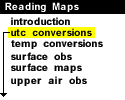
|
Standard Time:
When converting from Coordinated Universal Time (UTC),
first use the conversion table below.
From UTC to Local Time:
| Eastern Standard Time (EST) | UTC - 5 hours = EST | |
| Central Standard Time (CST) | UTC - 6 hours = CST | |
| Mountain Standard Time (MST) | UTC - 7 hours = MST | |
| Pacific Standard Time (PST) | UTC - 8 hours = PST |
Next, the local time is converted from a 24 Hour Clock to an AM/PM time.
Some Examples:
|
If the local time on the 24 hour clock is less than 0000, then you have crossed over to the previous day. So for example, -0400 becomes 2000 the day before. | |||||
Daylight Saving Time:
When converting from UTC to Daylight Saving Time,
the conversions are similar but the UTC Time is one hour less than when
converting than its Standard Time counterpart.
First use the conversion table below.
From UTC to Local Time:
| Eastern Daylight Time (EDT) | UTC - 4 hours = EDT | |
| Central Daylight Time (CDT) | UTC - 5 hours = CDT | |
| Mountain Daylight Time (MDT) | UTC - 6 hours = MDT | |
| Pacific Daylight Time (PST) | UTC - 7 hours = PDT |
Next, the local time is converted from a
24 Hour Clock to an AM/PM time.
Some Examples:
|
If the local time on the 24 hour clock is less than 0000, then you have crossed over to the previous day. So for example, -0400 becomes 2000 the day before. | |||||

am/pm to utc |
|

Reading Maps |



